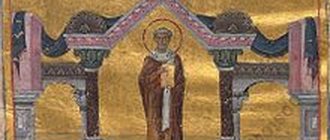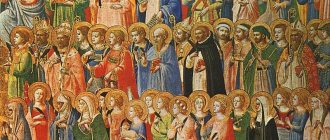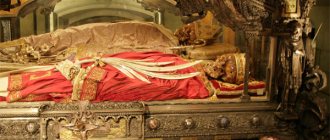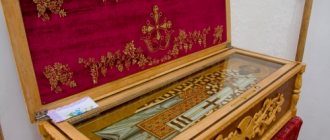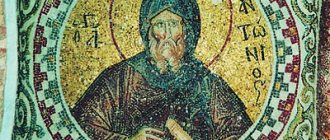Pope Clement I (Clement of Rome), is the first of the successors of St. Peter and the first of the “apostolic fathers.” His memory is celebrated on November 23 by Catholics, and on November 25 by Orthodox.
Clement of Rome was one of the Church Fathers who lived and ministered at the end of the Apostolic Age towards the end of the first century. The Church Fathers spread the Gospel, defended the Christian Church in apologetic writing, and fought against numerous heresies.
It is known that Clement of Rome wrote an Epistle to the Church in Corinth. This epistle is sometimes called the First Epistle to the Corinthians by Clement I. There is also a Second Epistle, but many question its authenticity.
Many other theological works are controversially or erroneously also attributed to Pope Clement.
Fourth Pope.
St. Clement of Rome was the third successor of the Apostle Peter as Bishop of Rome, and therefore is the fourth Pope. His ministry as Pope most likely lasted from 92 to 101. His predecessors are Linus/Lin and Cletus/Clet.
According to Tertullian, Clement of Rome was ordained by Saint Peter. St. Jerome claimed that Clement was the immediate successor of the Apostle Peter. Clement was the fourth Pope.
Origen identifies Pope Clement I with a fellow colleague of Paul who is mentioned in the Epistle to the Philippians.
I ask you, sincere co-worker, to help them, who labored in the gospel together with me and with Clement and with my other co-workers, whose names are in the book of life.
However, there is no way to confirm or refute this version. There is no convincing evidence that Clement of Rome was personally acquainted with at least one of the apostles.
Some also identify Clement of Rome with the consul Flavius Clement, who was killed by his cousin at the end of his consulate, however, this is a mistaken opinion. It is unlikely that Clement of Rome was a member of the imperial family. The constant use of quotations from the Old Testament in theological works indicates that Clement of Rome was probably of Jewish origin.
It is also very likely that he was a freedman or the son of a freedman. His family may have lived in Rome.
Reverence
Saints Cyril and Methodius bring the relics of Saint Clement to Rome.
11th century fresco from the Basilica of St. Clement Living long before the division of churches, St. Clement of Rome is equally revered by both the Orthodox and Catholic churches. St. Clement was widely revered in Rus'; Significant churches in Moscow (Church of Clement, Pope), Torzhok and other places are dedicated to him. This is due to the fact that the relics of Pope Clement were found, according to legend, by Saint Cyril Equal to the Apostles (according to some sources, together with his brother, Saint Methodius Equal to the Apostles) in the Crimean Korsun (Chersonese) around 861. Saint Cyril, Equal to the Apostles, personally transported the relics to Rome and handed them over to Pope Adrian II, where they were given an unprecedented celebration (late 867 - early 868). Pope Adrian II approved worship in the Slavic language and ordered the translated books to be placed in Roman churches. Methodius was ordained to the rank of bishop. According to some authors, it was the discovery of the relics of St. Clement that sanctified in the eyes of the Roman Church the educational mission of Cyril and Methodius among the Slavs and the introduction of worship in the Slavic language. Previously, the prevailing view among some theologians of the Western Church was that praise to God could only be given in three “sacred” languages (Hebrew, Greek and Latin), so the brothers were suspected of heresy and summoned to Rome. In honor of the discovery of the relics, Saint Cyril wrote a short story, a word of praise and a hymn in Greek. The first two works have come to us in a Slavic translation, which has the inscription “The Word on the Transfer by the Power of the Glorious Clement, a Historical Conversation” (a number of researchers call it the “Korsun Legend”). The relics of Saint Clement were transferred to Rome's Basilica of Saint Clement. Saint Cyril, who died in February 869, was also buried here.
Part of the relics of Saint Clement was left in Chersonesus, where it rested in a carved six-ton marble tomb made by Byzantine craftsmen from Prokonesian marble. After the capture of the city by Prince Vladimir the Great in 988 or 989, the relics of St. Clement (along with the marble sarcophagus) were, by his order, transferred to Kyiv, where they rested in the Tithe Church - the first stone church of Kievan Rus.
After all this, Vladimir took the queen, and Anastas, and the priests of Korsun with the relics of St. Clement, and Thebes, his disciple, took both church vessels and icons for blessing himself[9].
Apparently, a new reliquary was made for the relics of St. Clement, since Vladimir’s son Yaroslav the Wise was buried on February 20, 1054 in Kyiv in the Chersonesus marble tomb of St. Clement, preserved in the St. Sophia Cathedral to this day.
The “Word on the Renewal of the Church of the Tithes” (11th century) testifies to the deep veneration of St. Clement in Rus'. In it, Clement is defined as the first heavenly patron of the Russian land, whose relics were for some time, along with Olga’s Cross, the only and main Russian shrine.
...The Church sun, his saint, and our intercessor, a saint worthy of this name, the Hieromartyr Clement from Rome to Chersonesos, and from Chersonesos to our Russian country, Christ our God brought, with His abundant mercy, for the salvation of us believers...[10]
A particle of the relics from the venerable head of the holy martyr Clement was transferred from Kyiv to the Inkerman St. Clement Monastery after the resumption of its work in 1991; The shrine with holy relics was installed in the side nave of the St. Clement Church.
Part of the relics of Clement was transferred to the French bishop of Chalon, who came as part of the embassy to marry the daughter of Prince Yaroslav, Anna Yaroslavna, to the French king.
When Henry, King of France, sent the Bishop of Chalons Roger [11] to Rabastia for the daughter of the king of that country, named Anna, whom he was to marry, Abbot Odalric asked that bishop if he would deign to find out whether Chersonesus was located in those parts , in which, as they write, Saint Clement rests... The bishop fulfilled this. [The following is a story about the fate of the relics of St. Clement, discovered by Roger, to his surprise, in Kyiv, where he was heading as part of the embassy][12].
Chersonesos as the resting place of St. Clement was known in Europe. For example, the above-mentioned envoy of the French king asked Grand Duke Yaroslav the Wise:
Isn’t Kherson in those places where, as they say, Clement rested; does the sea still recede on his birthday and become accessible to those passing by?[13]
In the 13th century, the French monk Guillaume de Rubruck wrote:
And sailing in front of this city, we saw an island on which there was a famous temple, built, as they say, “by the hands of angels”... The above-mentioned region of Caesarea (Crimea) is surrounded by the sea on three sides, namely from the west, where Kerson, the city of Clement, is located... [8]
The monument to the holy martyr Clement of Rome in the Cossack Bay of Sevastopol was erected at the end of December 2021 and consecrated on January 12, 2020[14].
Martyrdom of Clement of Rome.
Nothing is known for sure about the life and death of Saint Clement of Rome. We learn about his biography mainly from apocryphal texts.
Around 110, Clement of Rome was sentenced to martyrdom by Emperor Trajan. Even before this, he was exiled to Crimea, but successfully preached there. According to historical data, thanks to his activities, more than 2,000 people living in Crimea became Christians, and more than 75 churches were built. Trajan ordered Clement of Rome to be tied to an anchor and thrown into the sea.
Content
- 1 Biography 1.1 Evidence from early Christian sources
- 1.2 Life of Saint Clement
- 1.3 The emergence of the legend of martyrdom in Chersonesos and the discovery of relics
- 1.4 Saint Clement and Titus Flavius Clement
- 3.1 First Epistle to the Corinthians
Literature
- Clement, popes and antipopes // Encyclopedic Dictionary of Brockhaus and Efron: in 86 volumes (82 volumes and 4 additional). - St. Petersburg, 1890-1907.
- The Life and Suffering of the Holy Hieromartyr Clement, Pope of Rome // Lives of the Saints in Russian, set out according to the guidance of the Chetyih-Menya of St. Demetrius of Rostov: 12 books, 2 books. add. - M.: Moscow. Synod. typ., 1903-1916. — Vol. III: November, Day 25. — P. 700.
- Memory of the holy apostles Apellius, Luke and Clement // Lives of the saints in Russian, set out according to the guidance of the Chetyih-Menya of St. Demetrius of Rostov: 12 books, 2 books. add. - M.: Moscow. Synod. typ., 1903-1916. — Vol. I: September, Day 10. — P. 235.
Russian translations:
- Clement, Pope
, Epistle to the Corinthians. / Per. from Greek I. Dmitrevsky. M., 1781. 80 pp. - First message. // Christian reading. 1824, part 4.
- Prot.
Peter Preobrazhensky. Monuments of ancient Christian writing, vol. II. Writings of the Apostolic Men // M.: 1860 First Epistle of Clement of Rome to the Corinthians - Second Epistle of Clement of Rome
- reprint: M.: IS ROC, 2003. pp. 135-191; St. Petersburg: Amphora, 2007. pp. 103-202.
Research:
- Savvaitov P.I.
Saint Clement, bishop. Roman. Patrological experience. St. Petersburg, 1852. - Augustine (Gulyanitsky), bishop.
Two district epistles of St. Clement of Rome on virginity, or to virgins and virgins. - Proceedings of the Kiev Theological Academy, 1869, May, 193-201. - Selin, A. A.
On the dedication of rural churches in the Novgorod land of the 16th century. St. Clement (Pope) // Theoretical conference “Philosophy of Religion and Religious Philosophy: Russia. West. East". St. Petersburg, 1995, 80-82. - Ukhanova, E. V.
Cult of St. Clement, Pope of Rome, in the history of the Byzantine and Old Russian churches of the 9th - first half of the 11th centuries. // Annali del'Istituto universario Orientale di Napoli. Aion Slavistica, 5, 1997-1998, 514-519. - Zadvorny, V. L.
First Epistle of Clement I to the Corinthians Archived copy of March 5, 2021 on the Wayback Machine // Same. Writings of the Roman pontiffs of late Antiquity and the early Middle Ages (I-IX centuries). M., ed. Franciscans, 2011, 27-32. - Zadvorny, V. L.
Clement I - the first heavenly patron of Ancient Russia Archival copy of April 19, 2014 on the Wayback Machine // Aka. Writings of the Roman pontiffs of late Antiquity and the early Middle Ages (I-IX centuries). M., ed. Franciscans, 2011, 274-280.
Conversion to Christ
One day, Divine Providence brought Clement together with a Christian, who told him about the Coming of the Redeemer into the world, the future resurrection, the Last Judgment, the eternal torment of sinners and the eternal bliss of saints. Touched to the depths of his heart by what he heard, Clement left his Roman home and went to Palestine.
Here, in Caesarea in Palestine, he met the supreme apostle Peter. After Peter enlightened him with the light of the Gospel Truth, Clement accepted Holy Baptism and entered the circle of his disciples. Soon, with the help of God, his parents were found. They also received Baptism from the Apostle Peter.
Notes
- According to some researchers, these may be other places in the vicinity of Chersonesus, for example, marble quarries on the shore of Cossack Bay, but the Orthodox tradition speaks specifically about the Inkerman quarries.
- Orthodox sources consider the resting place of St. Clement to be Cossack Bay in the western part of the Heraclean Peninsula.
- Lives of the Saints of Rostov, November 25, 1903-1916.
- E. V. Ukhanova. Finding the relics of St. Clement, Pope of Rome, in the context of the internal and foreign policy of the Byzantine Empire of the 9th century. Byzantine temporary book, vol. 59, M., “Science”, p. 116 (unspecified)
(inaccessible link). Date accessed: January 27, 2021. Archived February 5, 2021. - Finding the relics of St. Clement of Rome in Chersonesos
- B.Florya. Tales about the beginning of Slavic writing
- Gaius Suetonius Tranquillus. The Life of the Twelve Caesars. M.: Nauka, 1993.
- ↑ 12
Right there. - The Tale of Bygone Years. Translation by D. S. Likhachev.
- Word on the renewal of the Tithe Church / Transl. Vitaly Zadvorny // Truth and Life. 1994. No. 10. P. 38.
- Roger is the French bishop of Chalons-on-Marne in Champagne.
- Nazarenko A.V.
“Western European sources.”
Page 354. Per. A. V. Nazarenko according to Glossa Remensis ad Psalterium Odalrici
. Paris, 1904 - Berthier-Delagarde A.L. Excavations of Chersonese // Materials on the archeology of Russia. St. Petersburg, 1893. No. 12. P.61.
- The monument to the holy martyr Clement of Rome was consecrated in Crimea (unspecified)
.
Pravoslavie.Ru
(14.01.2020). Access date: January 14, 2021. - 1 Cor. Clement of Rome 59:1-2; quoted from the publication: St. Clement Bp. Rimsk. to Corinth. Epistle 1. - Scriptures of the Apostolic Men (in Russian translation, with an introduction and note by Archpriest P. Preobrazhensky). - St. Petersburg, 1895
- Evangelisches Kirchenlexikon, Bd. 1. Göttingen: Vandenhoeck & Ruprecht, 1986 - S. 518: “Auf dieser Bahn geht 1Clem weiter, der das Bischofsamt unmittelbar auf die ordnungsgemäße Einsetzung durch die Apostel zurückführt und damit erstmals den Gedanken apostolischer Suk zession anklingen läßt (44.2f)." .
- Quote from: Early Church Fathers. Brussels: “Life with God”, 1988 - p. 70
- See Grelot P., Dumais M. Homelies sur 1'Ecriture a Tepoque apostolique. - Paris, 1989. - P, 25 etc.).
- A. Pentkovsky
. Antiochian liturgical tradition in the IV-V centuries (inaccessible link) // Journal of the Moscow Patriarchate, 2002 (No. 2). - ↑ 12
Mercer dictionary of the Bible / ed. Watson E. Mills, Roger Aubrey Bullard. Macon, GA: Mercer University Press, 1997. pp. 160-161. - Augustine (Gulyanitsky), bishop.
Two district epistles of St. Clement of Rome on virginity, or to virgins and virgins. - Proceedings of the Kiev Theological Academy, 1869, May, 193-201. - A. I. Sidorov.
Patrolology course: the emergence of church writing. M., 1996
